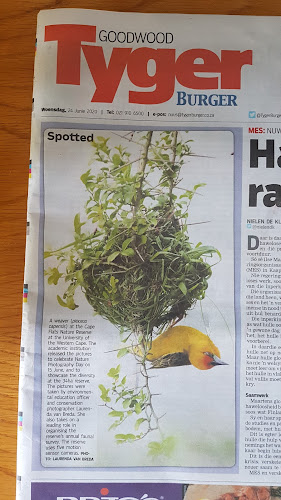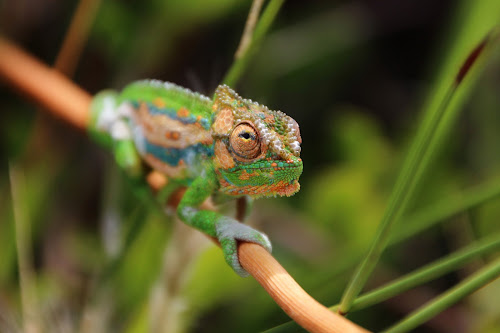Tuesday, 30 June 2020
Laurenda van Breda promotes Environmental Awareness through photography
Monday, 29 June 2020
The Cape Flats Nature Reserve at UWC celebrates their bustling animal life during June - Environment Month
Plastic attack on wildlife
We are constantly hearing marketing strategies and plights to save our oceans from pollution, save our oceans from plastic, but we don’t seem to hear the same ‘wooha’ about the land animals. When we hear or see terrible things every day, we almost become immune to the message which is so sad. On the other hand we might think “I recycle”, “I throw my trash in the bin”, “I’m doing my bit” and leave it at that without creating further awareness of the problem. In my job we try and create awareness about nature and recycling and provide the bins at the entrance to the nature reserve…we thought “we’re doing a good job”, “there have been no problems”…until recently. On a recent patrol we were shocked to discover trash bags ripped to shreds in the reserve and several animal scat filled with plastic!
Was it from the bins, someone who dumped a full bag of trash in the reserve, or did it bring the bag in from outside…we don’t know. What we do know is that we are clearly NOT doing enough in the awareness department, but this will change!
Marine life often mistake plastic bags for jellyfish, while land animals scavenge through rubbish when they smell food. Ingested plastic stays in the animals gut, it cannot be digested…this prevents food digestion which can lead to starvation and a very slow painful death. Did you know it can take up to 1000 years for plastic to break down?! Once the animal dies and decays, the plastic is released back into the environment to claim its next victim.
We are surrounded by so many nature reserves and natural areas right on our doorsteps, at UWC, literally on our doorstep. Do you know what animals are in your area? When you learn to love the animals you are surrounded by, you are more likely to make a conscious decision to protect them.
Tips:
- Ensure animals can’t reach into your bin to pull out bags…mongoose and caracals are sneaky animals (this includes domestic animals).
- Snakes are attracted to rubbish heaps, so keeping your property clean will help keep them away.
Written by Laurenda van Breda
YOUR INPUT COUNTS!!
Should the Cape Flats Nature Reserve keep its two bins (one inside the reserve at each entrance) or close them and create more awareness that it is a bin-free area and all rubbish should be taken back out with them?
Links on the topic to help you make an informed decision:
Bin and gone: Government gets rid of 40 bins from Hong Kong hiking trails in order to 'reduce waste'
https://www.scmp.com/news/hong-kong/health-environment/article/1859952/bin-and-gone-hong-kong-hiking-trails-see-bins
Parks are experimenting with removing waste receptacles altogether.
https://www.citylab.com/life/2015/11/fewer-trash-cans-less-trash/415023/
Containers will ruin conservation areas,’ say wheelie bin campaigners
http://archive.camdennewjournal.com/news/2012/apr/%E2%80%98containers-will-ruin-conservation-areas%E2%80%99-say-wheelie-bin-campaigners
Table Bay Nature Reserve's quarterly report: ”Refuse bins were phased out at public picnic and braai areas of the Table Bay Nature Reserve’s Rietvlei Water Area during this quarter. Refuse bins in public visitor areas do not promote a culture of taking responsibility for one’s own refuse. Many other nature reserves and national parks are also changing their approach to managing refuse collection in visitor areas, and requesting visitors to take out everything that they bring in with them. Small refuse bags were offered to visitors free of charge at the main entrance gate, and they were allowed in the interim to drop off their refuse at designated drop-off points in the Nature Reserve. By the end of the year all visitors will be responsible for the legal disposal of their own refuse.” http://www.friendsofrietvlei.co.za/documents/2014-Q3.pdf
Bracken Nature Reserve
This reserve has a “no-bin policy” and all visitors are encouraged to recycle and re-use all the recyclable materials. Please don't litter.
http://www.capetown.gov.za/Family%20and%20home/see-all-city-facilities/our-recreational-facilities/Nature%20reserves/Bracken%20Nature%20Reserve
Call for council to provide more bins at Braywick Nature Reserve
Nature Reserve Leads by example saving water
UWC Nature Reserve on fire
Fynbos is fire-adapted vegetation that requires regular burning for its survival. In the absence of fire, fynbos is gradually replaced by thicket species. It thrives on infertile soils and fire is the mechanism that recycles precious nutrients from old moribund growth into the soil.
Fire in fynbos is far from a disaster, but rather a crucial trigger that resets the fynbos ‘successional clock’. It provides the stimulus for dormant seeds to germinate and the opportunity for many annuals, short-lived perennials and bulbs to grow, flower and seed during times of abundant nutrients and sunlight. They complete their short life cycles, returning to the soil as the larger shrubs overwhelm them, and remain dormant until the next fire. The optimal fire cycle for fynbos is between 10-14 years. However, shorter fire cycles (caused accidentally by broken glass, cigarettes, etc) can wipe out species.
The reserve had an accidental fire in 2012; we are fortunate that this fire did not overlap the previously burnt area. To prevent damaging uncontrolled fires in the future, a controlled burn has been planned for 2017.
Endangered on our doorstep
False Bay Unique Ranger
Kedestes lenis lenis
 |
| False Bay Unique Ranger (Kedestes lenis lenis) |
 |
| Distribution map |
Euphorbia marlothiana: a closer look
 |
| Euphorbia caput-medusae |
 |
| Image 1 |
However, it was observed that the seeds were always missing from the seed pods. Each seed pod examined had a tiny hole in it (image 2)
 |
| Image 2 |
Upon further investigation, we discovered a larva in each seed pod (image 3). Could this be from a parasitic insect? This larval activity was seen during February 2014. The seed pods found during July had holes in but were empty.
 |
| Image 3 |
A first for the Cape Peninsula
 |
| Black Percher (Diplacodes lefebrvirii) female |
 |
| Distribution map |
 |
| Black Percher (Diplacodes lefebrvirii) male |
Creative erosion control
Thamnochortus insignis: The silent invader at UWC - Cape Flats Nature Reserve
The family Restionaceae is characteristic of the pyrophytic Fynbos biome, in which Thamnochortus is one of the largest of 58 genera. Two Thamnochortus species are endemic to the UWC - Cape Flats Nature Reserve. Today a third species, T. insignis which is the preferred thatching reed of this genus is also present. Effective management requires fire remediation; therefore T. insignis cannot be ignored.
- Established in the 1970's, proudly owned by University of the Western Cape
- Today a Private Nature Reserve and Provincial Heritage Site
- Host to both Cape Flats Sand Fynbos and Cape Flats Dune Strandveld vegetation types
- Five species of Restionaceae are endemic: Thamnochortus erectus, T. spicigerus, Chondropetalum microcarpum, Restio eleocharis and Willdenowia teres

- A multi-million rand industry and key source of income to small-scale farmers and local thatchers
- High demand lead to an increase in cultivation and distribution of restios
- High potential for mismanagement and incorrect thatching procedures
- Thatching Association of SA - not enforced by legislation
- T. insignis beyond its natural range due to: transportation (Haaksma 2000) and improper protocol (Campbell 2006)
- Field work (conducted May 2012 on female plants)
- Plant identification: Flowering Plants of the Cape Flats Nature Reserve (Low 1983), DELTA
- Key - Description Language for Taxonomy (Linder 2006) and site visit in May 2012 by CREW -Custodians of Rare and Endangered Wildflowers (Tygerberg)
- Rhizome comparison - three Thamnochortus species
- GPS co-ordinates (structures and female T. insignis)
- Inspection of thatch structures - spikelets present in thatch
- Flower morphology - Cape Plants (Goldblatt and Manning 2000) and Restios of the Fynbos Haaksma 2000)
- Cape Flats Nature Reserve is vulnerable to invasion due to its small size and isolation through urbanization
- Indigenous species are often more successful “invaders” than non-indigenous species in areas of high endemism
- Within pyrophytic environments most plants are either re-sprouters or re-seeders
- T. erectus is classed as a sister group to T. insignis (Verdu et al. 2007)
- T. insignis (re-seeders) – T. erectus and T. spicigerus (re-sprouters)
- Re-seeders generate only from seed-bank post fire, whilst re-sprouters generate from both rhizomes and seed-bank
- Re-seeders have a shorter life span than re-sprouters, hence they are able to build a greater seed-bank than re-sprouters
- T. insignis is a pioneer species and favours disturbance, whilst T. erectus is considered as a component of a climax community within a pyrophytic environment
- Prevents competitive exclusion within the community and thus promotes biodiversity within
- Increases available nutrients and the reduction of granivory and herbivory
- Considered as a vector for the establishment and spread of invasive species.
- Necessary in preserving biodiversity over a long period of time and is an important factor which has driven divergence with Fynbos































